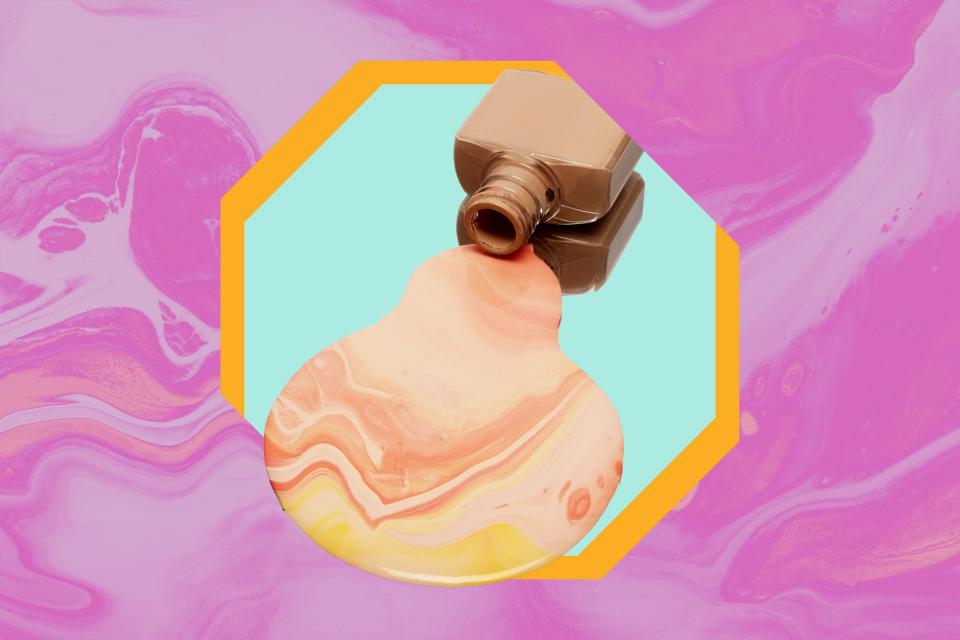A New Study Found High Levels of Toxic 'Forever Chemicals' In 120 Cosmetic Products
To the untrained eye, the lengthy ingredient list on the back of mascara packaging or a bottle of foundation looks like it's written in some alien-like language. Without being able to decipher all those eight-syllable ingredient names on your own, you have to put quite a bit of trust - that your makeup is safe and that its ingredient list is accurate - into the scientists who concoct your products' formulas. But a new study published in the journal Environmental Science and Technology Letters shows that, maybe, you shouldn't be so quick to trust what you're putting on your face and body.
After testing 231 cosmetics - including foundations, mascaras, concealers, and lip, eye, and eyebrow products - from stores such as Ulta Beauty, Sephora, and Target, the University of Notre Dame researchers found that 52 percent contained high levels of per- and polyfluoroalkyl substances (PFAS). Dubbed "forever chemicals," PFAS don't break down in the environment and can build up in your body with repeated exposure over time, such as by drinking contaminated water, eating fish from that water, or accidentally swallowing contaminated soil or dust, according to the Centers for Disease Control and Prevention. These chemicals are commonly used in non-stick cookware, water-repellent clothing, and stain resistant fabrics, per the CDC.
Within the beauty world, PFAS are often added to cosmetics and personal care products (think: lotions, face cleansers, shaving creams) to improve their water resistance, consistency, and durability, according to the study. On ingredient labels, PFAS will often include the word "fluoro" in their names, according to the Environmental Working Group, but the study found that only 8 percent of the tested cosmetics had any PFAS listed as ingredients. Of all eight cosmetic categories tested, foundations, eye products, mascaras, and lip products made up the greatest portion of products containing high amounts of fluorine (a marker for PFAS), according to the researchers. (Related: The Best Clean and Natural Mascaras)
It's unclear whether or not the PFAS were intentionally added to these products or not, but the researchers point out that they could have been contaminated during manufacturing or from the leaching of storage containers. The U.S. Food and Drug Administration also notes that some PFAS may be unintentionally present in cosmetics due to raw material impurities or "the breakdown of PFAS ingredients that form other types of PFAS."

Getty Images - Design: Alex Sandoval
Regardless of the cause, the presence of these chemicals is a bit unsettling: Exposure to high levels of certain PFAS may lead to elevated cholesterol levels, decreased vaccine response in children, increased risk of high blood pressure in pregnant women, and increased risk of kidney and testicular cancer, according to the CDC. Animal studies - using doses much higher than levels found naturally in the environment - have also shown that PFAS can cause damage to the liver and immune system, birth defects, delayed development, and newborn deaths, per the CDC.
While those potential health risks make the use of PFAS in cosmetics a cause for concern, experts caution against automatically assuming the worst. "It is unknown how much is actually getting absorbed [through the skin] and how much people are exposed to based on the amount found in the makeup products," says Marisa Garshick, M.D., F.A.A.D., a dermatologist in New York City. "So just because those [effects] were [seen in] the studies performed on animals, which were given a large amount [of PFAS], it does not mean that would apply in this setting, where the amount of exposure is unknown."
Still, it's important to note that the cosmetics tested in the study may be applied to the face, including around the eyes and mouth - areas "where the skin is generally thinner and there may be increased absorption compared to other parts of the body," says Dr. Garshick. Likewise, the study authors point out that the PFAS in lipstick could unintentionally be ingested, and those in mascara could potentially be absorbed through the tear ducts. (Also read: What's the Difference Between Clean and Natural Beauty Products?)
So, should you toss all your makeup in the trash? It's complicated. A 2018 report on PFAS in cosmetics, conducted by Denmark's Environmental Protection Agency, determined that "measured concentrations of PFCA [a type of PFAS] in cosmetic products themselves do not pose a risk to consumers." But in the extreme worst case scenario - which the authors note isn't particularly realistic - there could be a risk if multiple cosmetics containing PFAS are used simultaneously. (Related: The New 'Toxic Beauty' Documentary Shines a Light On the Dangers of Unregulated Cosmetics)
TL;DR: "Because overall data is limited, firm conclusions cannot be drawn," says Dr. Garshick. "More research is needed to evaluate the amount of PFAS found in cosmetics, the extent of absorption through the skin, and the health risks associated with this exposure."
Even though the potential harm of PFAS in cosmetics is still up in the air, there are steps you can take to minimize your exposure. The EWG, which was not involved in the study, recommends checking its Skin Deep Database, which offers ingredient lists and safety ratings for nearly 75,000 cosmetics and personal care products - including 300+ that EWG researchers have identified as containing PFAS, before you add a product to your beauty routine. More importantly, you can call up your congress members and advocate for legislation that bans PFAS in cosmetics, such as The No PFAS in Cosmetics Act introduced yesterday by Senators Susan Collins and Richard Blumenthal.
And if you're still concerned, there's nothing wrong with going au naturel for good, à la Alicia Keys.

